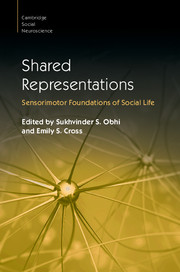Book contents
- Shared Representations
- Cambridge Social Neuroscience
- Shared Representations
- Copyright page
- Contents
- Figures
- Tables
- Boxes
- Contributors
- Preface
- Part I Foundations
- Part II Imitation and Mimicry
- Part III Thinking, Perceiving and Acting with Others
- 10 Levels of Complexity and the Duality of Gaze
- 11 Acting Together
- 12 Joint Perception
- 13 Social Antecedents and Consequences of Behavioral Synchrony
- 14 Musical Ensemble Performance
- Part IV Understanding Others
- Part V Learning and Development
- Part VI Shared Representations in Applied Contexts
- Index
- Plate Section (PDF Only)
- References
13 - Social Antecedents and Consequences of Behavioral Synchrony
from Part III - Thinking, Perceiving and Acting with Others
Published online by Cambridge University Press: 27 October 2016
- Shared Representations
- Cambridge Social Neuroscience
- Shared Representations
- Copyright page
- Contents
- Figures
- Tables
- Boxes
- Contributors
- Preface
- Part I Foundations
- Part II Imitation and Mimicry
- Part III Thinking, Perceiving and Acting with Others
- 10 Levels of Complexity and the Duality of Gaze
- 11 Acting Together
- 12 Joint Perception
- 13 Social Antecedents and Consequences of Behavioral Synchrony
- 14 Musical Ensemble Performance
- Part IV Understanding Others
- Part V Learning and Development
- Part VI Shared Representations in Applied Contexts
- Index
- Plate Section (PDF Only)
- References
Summary
Behavioral synchronization is one mechanism through which people coordinate their behavior in social interactions. Researchers from a wide range of scientific disciplines have examined the social antecedents and consequences of behavioral synchrony. At the core of this research lies the double assumption that people spontaneously synchronize their behavior during social interactions, and that synchronized movement rhythms transform individuals into a social unit. Recent experimental research has started to offer converging support for these theoretical ideas. In the present chapter, we will first define behavioral synchrony and review early research on movement synchrony. Subsequently, we discuss how behavioral synchrony is measured using frame-by-frame analysis, judgments of synchrony by observers, movement tracking devices or automatic motion analysis. We then provide an overview of recent studies on how synchrony emerges, focusing both on a dynamic systems perspective, as a cognitive perspective based on common coding theory. Finally, we review research on the consequences of behavioral synchrony, on the affective, behavioral and cognitive consequences of moving in synchrony. The research discussed in this chapter points towards the fundamental role synchrony plays in social interaction. The tendency to synchronize, together with the emergence of a social unit when individuals move in synchrony, seems to indicate that people have a predisposition to socially connect to others through mutual adaptation of behavioral rhythms.
- Type
- Chapter
- Information
- Shared RepresentationsSensorimotor Foundations of Social Life, pp. 254 - 279Publisher: Cambridge University PressPrint publication year: 2016
References
- 3
- Cited by



